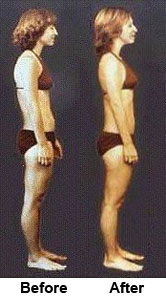Here are just two examples of common structural misalignments that Rolfing® Structural Integration can help correct.
Forward Head Posture
Forward Head Posture (FHP) is the formal name for slouched, stooped posture of the shoulders where the head is forward from the line of gravity, or plumb line. If the back of your ears are not aligned with your shoulders in profile, or if your head makes it through a doorway before your chest does, chances are you have some degree of FHP.
Common symptoms of FHP appear as tension in the jaw, upper back, neck pain, ”knots” in the shoulders, breathing difficulties, shooting pain down the arms, and various types of headaches.
“Head in forward posture can add up to thirty pounds of abnormal leverage on the cervical spine. This can pull the entire spine out of alignment.”1.
Over a series of sessions, Rolfing works to systematically achieve balance of all the structures that create a stable, adaptable, and supportive spine. Since the body adapts to FHP by shortening and stiffening some muscles, and stretching and weakening other muscles, learning proper sitting mechanics in a Rolfing therapy session can also be very important to correcting and eliminating FHP in your everyday activities.
Sway Back:
Also known as hyperlordosis, is when the pelvis is not horizontal to the ground in standing and is tilted too far forward causing excessive curve in the lumbar spine.
Common symptoms can appear as low back pain, tension in the hamstrings or hips, sciatica, spinal disc problems, and fatigue in standing for long periods. This posture is also very common post pregnancy.
Strengthening the back muscles, abdominals, and hip rotators may improve their function and reduce the symptoms of sway back, but won’t necessarily improve your posture because strength training these areas cannot rotate a pelvis backward. Rolfing practitioners work with the muscles and connective tissue in the front and backs of the hips and thighs to correct this misalignment and free the adhesions to allow the pelvis to derotate back into alignment.
Often times the two structural misalignment examples above are seen together, creating a host of structural compensations, stress-related illnesses, and the potential for injury.
The picture to the left is an example of before and after the 10-session series of Rolfing Structural Integration. Can you see Forward Head Posture and Sway Back in the “Before” picture? In the “After” picture?
Long term structural deviations and abnormal postures create muscle strain and chronic pain conditions leading up to disc herniations, arthritis, and pinched nerves. Rolfing Structural Integration can improve the structural misalignments that lead to the deterioration of your health with a gentle and intelligent touch.
Contact me today for a free consultation!
References:
1. Dalton, E., Ph.D. (2011). Forward Head Posture The 42 Pound Head [Head Forward Posture].
Retrieved December 18, 2011, from Freedom From Pain Institute website:
http://erikdalton.com/media/published-articles/forward-head-posture/
Gina Kilgus | Certified Rolfer | 4412 Spicewood Springs Rd #402 | Austin, TX | 78759 | Schedule a Session






